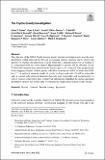The Psyche Gravity Investigation
Author(s)
Zuber, Maria T.; Park, Ryan S.; Elkins-Tanton, Linda T.; Bell, J. F.; Bruvold, Kristoffer N.; Bercovici, David; Bills, Bruce G.; Binzel, Richard P.; Jaumann, R.; Marchi, Simone; Raymond, Carol A.; Roatsch, T.; Wang, Charles C.; Weiss, Benjamin P.; Wenkert, Daniel; Wieczorek, Mark A.; ... Show more Show less
Download11214_2022_Article_905.pdf (1.916Mb)
Publisher with Creative Commons License
Publisher with Creative Commons License
Creative Commons Attribution
Terms of use
Metadata
Show full item recordAbstract
Abstract
The objective of the NASA Psyche mission gravity science investigation is to map the mass distribution within asteroid (16) Psyche to elucidate interior structure and to resolve the question of whether this metal-rich asteroid represents a remnant metal core or whether it is a primordial body that never melted. Measurements of gravity will be obtained via the X-band telecommunication system on the Psyche spacecraft, collected from progressively lower mapping altitudes. Orbital gravity will allow an estimate of
G
M
$GM$
to better than 0.001 km3 s−2. A spherical harmonic model of gravity to degree and order 10 will be achievable and, in concert with spherical harmonic data sets from topography and magnetometry, as well as surface composition data, will provide information regarding the spatial and radial distribution of mass that will be used to constrain the origin and evolution of (16) Psyche.
Date issued
2022-10-18Department
Massachusetts Institute of Technology. Department of Earth, Atmospheric, and Planetary SciencesPublisher
Springer Netherlands
Citation
Space Science Reviews. 2022 Oct 18;218(8):57
Version: Final published version